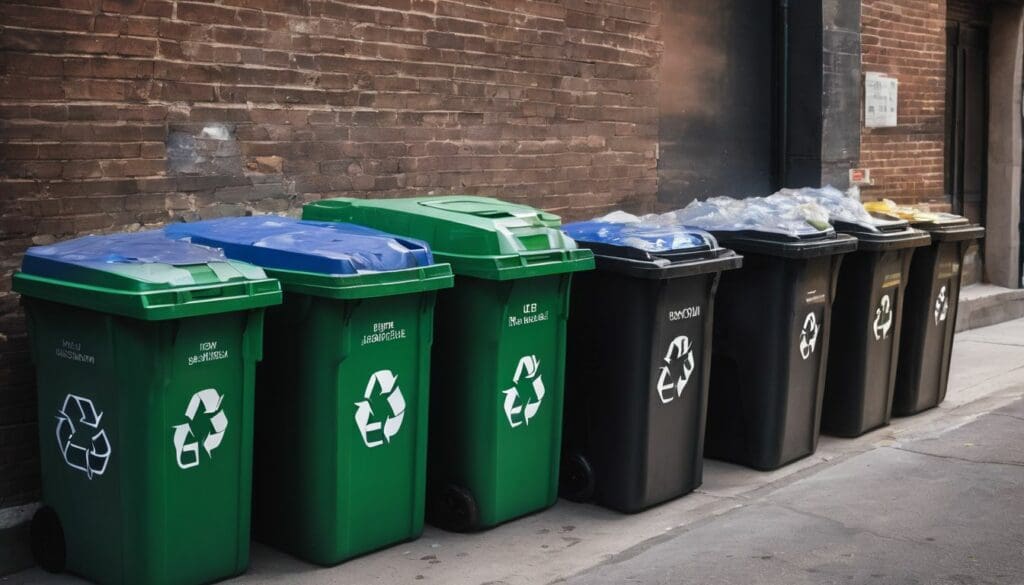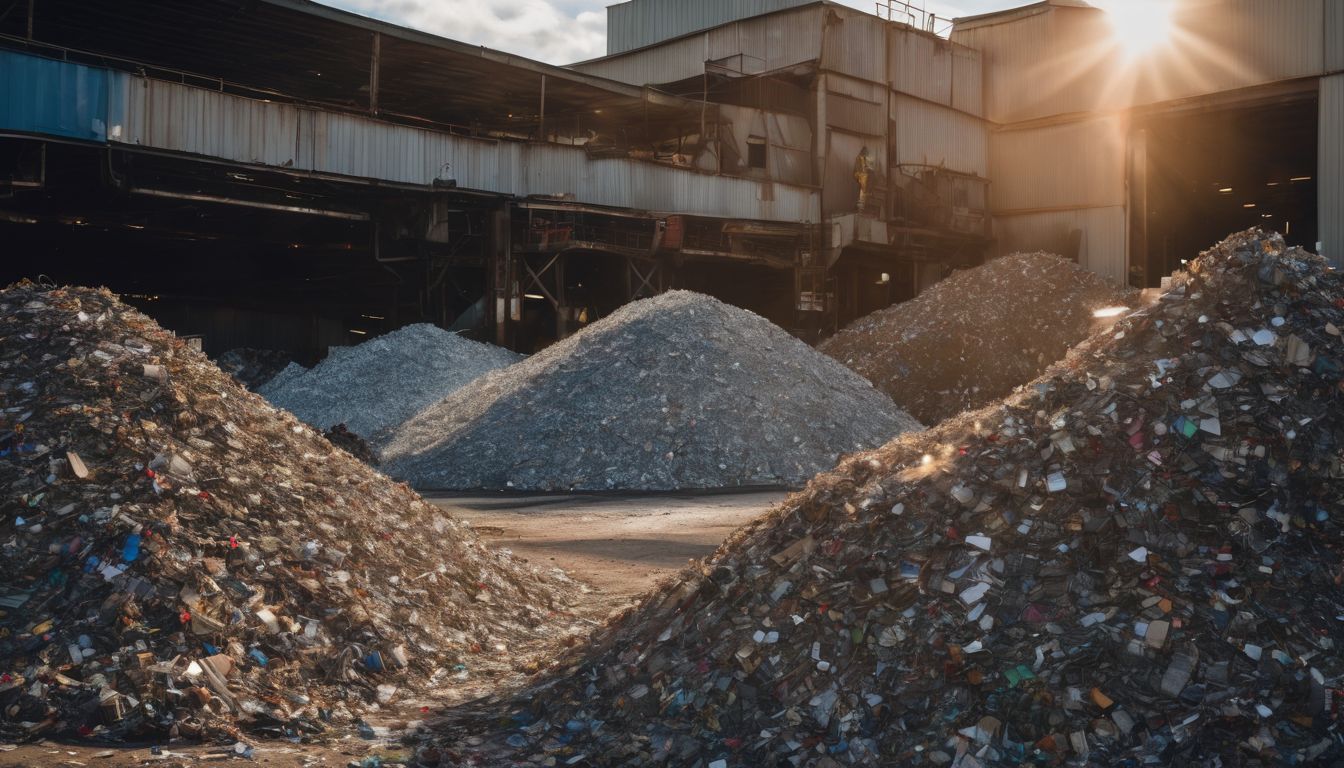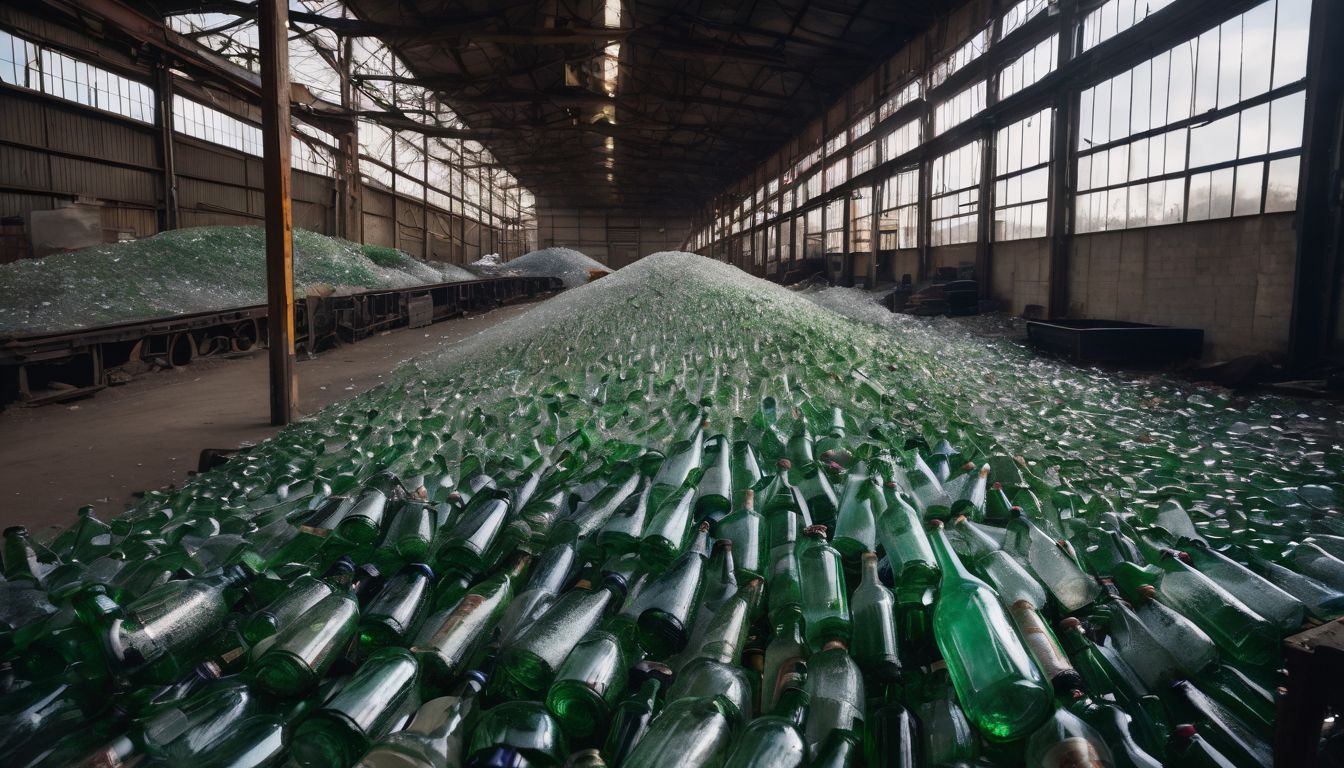Are you puzzled by what can and can’t be recycled in your local area? Each year, millions of tonnes of recyclable materials end up in landfill due to confusion about recycling policies.
Our article sheds light on the must-knows of council recycling rules, helping you become a savvy recycler. Dive in for clarity and do your bit for the planet!
Key Takeaways
- Recycling reduces waste in landfills, conserves natural resources, and lessens energy use; one tonne of recycled paper saves 17 trees and 7,000 gallons of water.
- The U.S. recycling system uses collected and processed materials for manufacturing new products, which supports the economy by creating jobs.
- Properly sorting recyclables is essential to prevent contamination; check local guidelines as recycling regulations can vary widely.
- Purchasing items made from recycled materials encourages sustainable production and helps develop a circular economy.
- Active participation in community recycling programs enhances environmental stewardship and improves quality of life for future generations.
Benefits of Recycling
Recycling benefits the environment by reducing landfill waste and conserving natural resources. It also supports the economy by creating jobs in recycling and manufacturing industries.
Environment
Recycling plays a crucial role in protecting the environment by reducing the need to extract and process raw materials. This conserves energy and natural resources, helping to preserve wildlife habitats and biodiversity.
Every tonne of paper recycled saves about 17 trees, illustrating how waste reduction strategies directly impact forest conservation. Efficient recycling programs also cut down on greenhouse gas emissions since producing new products from recycled materials requires less energy compared to starting from scratch with raw inputs.
Sustainable practices in waste management allow us to combat pollution by diverting tons of waste from landfills and oceans. Composting organic matter further reduces environmental footprints as it turns potential landfill material into nourishing soil amendments for gardens and crops.
Engaging in community recycling programs not only upholds environmental stewardship but also promotes resource conservation, ensuring a cleaner planet for future generations. Through these efforts, individuals contribute significantly towards sustainability initiatives that shape greener policies globally.
Economy
Moving on from the environmental benefits of recycling, let’s shift our focus to the positive impact it has on the economy. Recycling plays a crucial role in creating jobs and stimulating economic growth.
By reusing materials and reducing waste sent to landfills, recycling supports industries that depend on recycled materials as raw inputs for manufacturing. This lowers production costs and promotes sustainable practices throughout supply chains, resulting in a more efficient use of resources and increased competitiveness.
Furthermore, investing in recycling infrastructure drives innovation, technology development, and entrepreneurship within the green sector. As demand for recycled products increases, businesses are incentivised to invest in research and development, ultimately leading to new job opportunities and a stronger economy.
Community
Recycling has a positive impact on the community by reducing waste and preserving natural resources. Engaging in recycling not only benefits the environment but also contributes to local economies through job creation and resource conservation.
When individuals actively participate in recycling efforts, they play a crucial role in shaping sustainable communities for future generations.
Supporting recycling initiatives at the local level fosters a sense of shared responsibility among community members while promoting eco-friendly behaviours. By adhering to council recycling policies and regulations, communities can collectively work towards minimising environmental impact and creating a cleaner, healthier living environment for all residents.
The U. S. Recycling System
– The U.S. recycling system involves the collection and processing of recyclable materials, which are then used in manufacturing new products made from recycled materials.
– By understanding how the U.S. recycling system works, you can see the positive impact it has on the environment, economy, and community.
Collection and Processing
The collection and processing of recyclable materials involves several key steps:
- Waste is collected from homes, businesses, and public spaces.
- The collected materials are sorted to separate recyclables from non – recyclables.
- Recyclables are then processed through shredding, crushing, or melting to prepare them for manufacturing.
- The processed materials are then used by manufacturers to create new products.
- Recycling facilities play a vital role in ensuring that materials are properly handled and processed.
Manufacturing
Manufacturing processes are a crucial step in the recycling cycle, as they transform collected materials into new products. The collection and processing of recyclable materials by facilities lead to the creation of raw materials for manufacturing new items.
Using sourceseparated recyclable materials in manufacturing reduces the consumption of natural resources and energy, which aligns with green initiatives and environmental policies.
It also contributes to the economy by generating jobs within the recycling industry and reducing waste disposal costs.
Purchasing products made from recycled materials promotes a circular economy that supports conservation efforts. Understanding how manufacturing plays a vital role in the recycling process empowers individuals to make environmentally friendly purchasing decisions that positively impact our planet.
Purchasing New Products Made from Recycled Materials
When buying new products made from recycled materials, you contribute to reducing the demand for raw resources and help decrease environmental impact. By choosing items with recycled content, you support the recycling industry and promote a circular economy, where materials are reused rather than discarded.
Opting for goods made from recycled materials encourages manufacturers to incorporate sustainability into their supply chain, leading to eco-friendly production practices and reduced waste generation.
Moving on to the next topic about “Challenges and Solutions for Recycling.”
Challenges and Solutions for Recycling
Addressing the challenges to the recycling system is crucial for sustainable waste management. By understanding these issues and exploring potential solutions, we can work towards a more effective and efficient recycling process.
To learn more about how to overcome these challenges, keep reading.
Challenges to the Recycling System
Recycling systems face numerous challenges, including contamination of recyclables, lack of infrastructure to properly sort and process materials, and low consumer participation in recycling efforts.
The inefficient collection and processing of recyclables result in a significant portion being deemed unrecyclable due to cross-contamination or improper sorting. Additionally, the ongoing issue of non-recyclable items being mistakenly included in recycling bins further hampers the system’s effectiveness.
Moreover, limited investment in recycling facilities and technologies contributes to inadequate capacity for managing the growing volume of recyclable materials.
Inadequate education about recycling guidelines and lack of uniformity among local regulations also pose hurdles to effective waste management initiatives. Furthermore, fluctuating market demand for different types of recycled materials presents uncertainty for manufacturers seeking consistent sources for their production needs.
Government Initiatives
The government has implemented various initiatives to support recycling and environmental conservation. These include:
- Implementing federal recycling laws to regulate and promote recycling practices.
- Providing guidelines and requirements for solid waste facilities to ensure proper disposal of recyclable materials.
- Enforcing recycling regulations to monitor compliance and encourage responsible waste management.
- Offering assistance, forms, and reporting requirements for recycling facilities to streamline operations and maintain transparency.
- Providing contact information for recycling facilities for easy access and communication.
Consumer Actions
To support recycling and conservation efforts, environmentally conscious individuals can take the following actions:
- Reduce, Reuse, Recycle: Prioritise reducing consumption, reusing items whenever possible, and recycling materials to minimise waste.
- Educate Others: Spread awareness about the benefits of recycling and the importance of following disposal guidelines within your community and social circles.
- Support Sustainable Products: Choose products made from recycled materials to support the demand for sustainable goods.
- Proper Disposal: Ensure that you dispose of recyclable items according to local solid waste facility regulations and guidelines.
- Advocate for Change: Engage with local authorities and businesses to support initiatives that improve recycling infrastructure and accessibility.
- Stay Informed: Keep up-to-date with federal recycling laws and regulations to understand your rights and responsibilities as a consumer.
How to Recycle Common Materials
Learn how to properly recycle common materials such as paper, plastics, glass, aluminum, batteries and electronics in order to reduce waste and conserve resources. Understanding the correct process for recycling these items can make a big impact on the environment.
Paper and Cardboard
Recycling paper and cardboard helps conserve natural resources and reduces the amount of waste sent to landfills. When paper and cardboard are recycled, they can be turned into new products, saving energy and reducing greenhouse gas emissions.
- Paper and cardboard should be clean and dry before recycling.
- Remove any non – paper items such as metal clips or plastic windows from envelopes before recycling.
- Cardboard boxes should be flattened to save space in recycling bins or collection bags.
- It’s important to check with your local recycling facility for specific guidelines on what types of paper and cardboard they accept.
- Recycled paper and cardboard can be used to make new paper products like newspapers, tissue paper, and packaging materials.
- Recycling one ton of paper saves 17 trees, 7,000 gallons of water, 3 cubic yards of landfill space, and 4,100 kilowatt-hours of electricity.
Plastics
When it comes to recycling, plastics are a crucial material. They can be recycled into a variety of new products, helping to conserve resources and reduce waste. Here are the details on how to properly recycle plastics:
- Check for the Resin Identification Code: Look for the number inside the recycling symbol on plastic items. This code identifies the type of plastic used and helps determine if it’s recyclable in your area.
- Rinse and Clean Plastics: Before recycling, thoroughly rinse and clean plastic containers to remove any leftover food or debris. This ensures that the recycling process is more efficient.
- Avoid Contamination: Keep plastic items free from non-recyclable materials, such as caps or labels that may not be accepted by your local recycling facility.
- Recognise Accepted Plastics: Commonly accepted plastics include bottles, jugs, tubs, and containers marked with recycling codes 1 (PET), 2 (HDPE), and 5 (PP). These are often easily recyclable in most communities.
- Research Local Recycling Guidelines: Familiarise yourself with your local council’s guidelines on what types of plastics they accept for recycling. Some facilities may have specific requirements for certain types of plastics.
- Reduce Plastic Usage: Whenever possible, opt for reusable alternatives to single-use plastics to minimise the overall amount of waste produced.
- Support Recycled Plastic Products: Look for and purchase items made from recycled plastics to help create demand for these sustainable products in the market.
Glass
Recycling glass reduces energy consumption and greenhouse gas emissions. To recycle glass:
- Rinse the glass containers thoroughly before recycling.
- Check with your local recycling program to ensure they accept glass.
- Remove any caps, corks, or lids from the glass containers before recycling.
- Do not include ceramics, Pyrex, or mirrors in your glass recycling bin.
Aluminum
Recycling aluminum saves energy and reduces the need for mining. It also lessens the environmental impact of producing new aluminum. When recycling aluminum, follow these steps:
- Collecting: Aluminum cans are collected from households, businesses, and events.
- Sorting: At the recycling facility, aluminum is sorted from other materials like glass and plastic.
- Processing: The cans are shredded and melted in a furnace.
- Purifying: Impurities are skimmed off, leaving pure molten aluminum.
- Solidifying: The molten aluminum is poured into molds to form ingots or sheets.
- Manufacturing: The recycled aluminum is used to make new cans, car parts, or construction materials.
- Purchasing: Support recycling efforts by buying products made from recycled aluminum such as beverage cans or household items.
Batteries
When disposing of batteries, ensure they are not thrown in the regular rubbish. Instead, take them to a designated battery recycling facility or a collection point.
Electronics
- Many electronic items contain hazardous materials such as lead and mercury, making it important to recycle them properly.
- Find a certified e – waste recycling facility in your area where you can drop off old electronics for safe disposal and recycling.
- Consider donating working electronics to schools or non-profit organisations to extend their usability.
- Look for trade – in programmes offered by manufacturers and retailers when upgrading your electronic devices.
Understanding Recycling Policies and Regulations
In this section, we will delve into the federal recycling laws and the overview of requirements for recycling facilities. We will also explore the rules and assistance available to individuals and businesses when it comes to recycling, along with contact information for recycling facilities.
Federal Recycling Laws
Federal recycling laws regulate the handling, transportation, and disposal of waste materials. These laws are designed to reduce environmental pollution and promote sustainable practices.
They establish guidelines for recycling facilities, outlining the types of materials that must be recycled and how they should be processed. Federal regulations also require businesses to report their recycling efforts and demonstrate compliance with recycling targets.
By enforcing these laws, the government aims to decrease the amount of waste sent to landfills and encourage the reuse of valuable resources.
These federal regulations serve as a framework for state-level recycling legislation, setting minimum standards that states must adhere to while allowing them flexibility in crafting their own requirements.
Overview of Requirements for Recycling Facilities
Recycling facilities must meet specific requirements to comply with federal laws and regulations. These include maintaining proper records of materials received, processed, and sold; ensuring the facility’s infrastructure meets safety standards; and adhering to environmental protection guidelines.
Facilities also need to provide data on their recycling activities regularly, such as the types and quantities of materials collected and recycled. Additionally, they may be required to report any incidents that could potentially harm the environment or public health.
To operate effectively, recycling facilities should stay updated with state-specific rules and obtain necessary permits. The contact information for relevant regulatory bodies can assist in understanding these requirements for compliance.
Recycling Rules and Assistance
- Sorting Guidelines: Properly sort recyclable materials according to the guidelines provided by your local council or recycling facility to ensure effective processing.
- Collection Schedules: Familiarise yourself with the collection schedules for different types of recyclables in your area to ensure timely disposal.
- Recycling Education: Stay informed about educational resources and workshops offered by local authorities to enhance your understanding of recycling practices.
- Recycling Incentives: Explore any incentive programmes or rewards offered by recycling facilities or councils as a way to encourage participation and compliance with recycling policies.
- Accessibility and Infrastructure: Advocate for improved accessibility and infrastructure for recycling within your community, such as additional collection points or designated drop-off locations.
- Reporting Non-Compliance: Understand the process for reporting any non-compliance with recycling regulations and seek assistance from relevant authorities if needed.
- Collaboration Opportunities: Explore opportunities for collaboration with local organisations or businesses to promote sustainable waste management practices within the community.
Forms and Reporting Requirements
To ensure compliance with recycling policies, facilities are required to submit forms and reports. These records help authorities monitor recycling activities and track progress. Facilities must accurately complete these documents and submit them by specified deadlines to avoid penalties.
- Facility Registration: Recycling facilities are required to register with the relevant council or regulatory agency. This involves providing detailed information about the facility’s operations, materials processed, and environmental impact.
- Annual Reporting: Facilities must submit annual reports detailing the amount and types of materials recycled, as well as any challenges encountered. This information helps regulators assess the effectiveness of recycling programs.
- Material Tracking: Facilities need to maintain accurate records of incoming and outgoing materials, including their sources and destinations. This ensures transparency in the recycling process.
- Compliance Forms: Regular compliance forms are often required to demonstrate adherence to specific regulations, such as waste disposal guidelines or pollution control measures.
- Environmental Impact Assessments: Some facilities may be required to conduct periodic assessments of their environmental impact, including emissions, energy consumption, and waste management practices.
- Audits and Inspections: Regulatory bodies may conduct routine audits or inspections to verify compliance with recycling regulations and assess overall operational efficiency.
Contact Information for Recycling Facilities
Find a recycling facility near you by accessing the local council’s website. You can also contact them directly for information about drop-off locations and available services. Take action to support your community and environment.
After understanding where to find recycling facilities, let’s explore how federal laws impact the overall recycling system.
Conclusion
Understanding council recycling policies is crucial for promoting a green environment. Following federal recycling laws ensures proper disposal of materials and supports the circular economy.
Contacting local facilities for rules and assistance fosters community engagement in sustainable practices. Take action today to contribute to a cleaner, greener future for all.
FAQs
1. What are council recycling policies?
Council recycling policies are rules set by local councils that outline how residents should sort and dispose of recyclable materials to benefit the environment.
2. Why is it important to follow these policies?
Following council recycling policies helps reduce waste, saves energy, and supports our community in maintaining a clean and sustainable environment.
3. Where can I find information about my local council’s recycling policy?
You can usually find your local council’s recycling policy on their website or by contacting them directly for the most current information on how to recycle properly.
4. What items can I recycle under my council’s policy?
Each council may have different guidelines, but generally, you can recycle paper, cardboard, glass bottles, plastic containers and cans; check with your local authority for a specific list of recyclable items.





